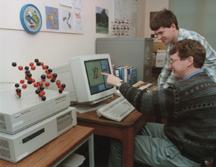
Computer simulation studies of minerals and ceramics

Computer simulation methods also play a large role in our work. These
studies include
- Lattice energy minimisation calculations. For silicates we use
"standard" empirical models that include ionic polarisability of the oxygen
anions, and bond-bending terms for the tetrahedra. Our work on
Al/Si
ordering is an example of our use of these calculations. The basic models
can be adapted for simulations of other ceramics, as illustrated in our
work on the new ceramic
ZrW2O8 that
has a negative thermal expansion.
- Lattice dynamics simulations, using the same empirical potentials, are
useful in the study of phase transitions and for thermodynamic modelling.
Examples include our work on the negative thermal expansion in
ZrW2O8,
and of the phase transitions and lattice dynamics in
calcite;
- Molecular dynamics simulations are used mostly for the study of
high-temperature phases and phase transitions, as in our work on
cristobalite;
- Monte Carlo simulations are used to study
Al/Si
ordering.
We undertake two kinds of simulation studies. One is where we try and
make the simulation as realistic as possible (within the computational
limits). For example, where we try to analyse the energetics of Al/Si
ordering, or structure instabilities. The second is where we use model
systems, where we only keep in the bare essentials of the physics. For
example, we have used very simple models (the so-called phi-4 model) to
study aspects of phase transitions and the links of the true thermodynamics
to simple models such as Landau theory.
Two programs we have developed in our work may be of interest, and
freely available:
-
CRUSH is a program to calculate the Rigid Unit Mode spectrum for a
given framework crystal structure. It is based on a molecular lattice
dynamics methods.
-
NMRFIT is a program to deduce the short-range Al/Si order in a framework
aluminosilicate mineral from Si MAS-NMR data by means of a Monte-Carlo
simulated anneal.
Advice on any aspects of both programs can be obtained by
email.
A
list
of papers related to this topic can be inspected.
Link back to ...
My
home page


